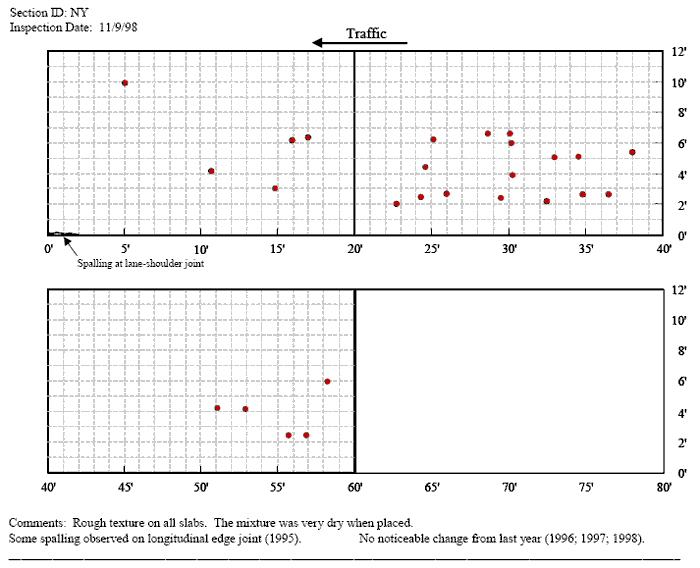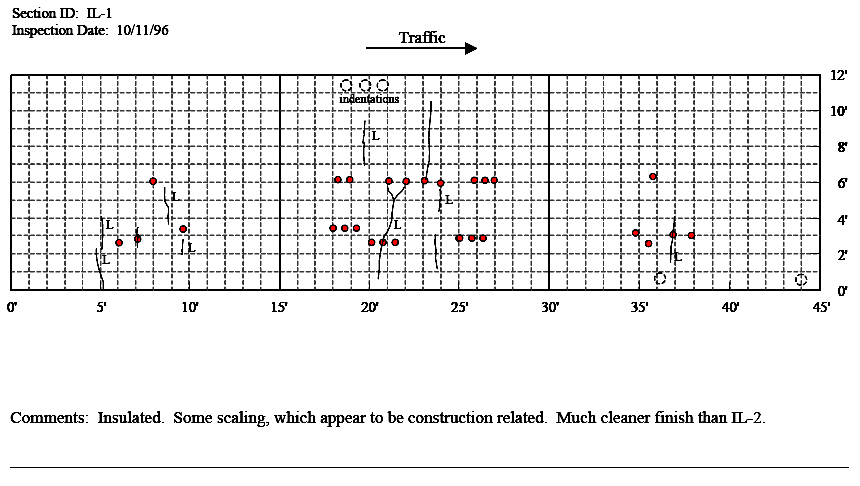U.S. Department of Transportation
Federal Highway Administration
1200 New Jersey Avenue, SE
Washington, DC 20590
202-366-4000
Federal Highway Administration Research and Technology
Coordinating, Developing, and Delivering Highway Transportation Innovations
 |
| This report is an archived publication and may contain dated technical, contact, and link information |
|
Publication Number: FHWA-RD-02-084 Date: May 2006 |
Distress survey maps representing the condition of the various patches are presented in figures 25 through 40 in this appendix. The circular dots on the maps indicate core locations. The patches in Arkansas, New York, and North Carolina did not sHow significant deterioration over time. Therefore, for these sections, distress maps are provided only for the years 1994 and 1998. On the other hand, sections in Illinois and Nebraska sHowed more pronounced deterioration over time. For these sites, distress maps are provided for all the years in which field surveys were conducted.

Figure 25. Graph. Distress map for patch NC-1 in North Carolina–1994.

Figure 26. Graph. Distress map for patch NC-1 in North Carolina–1998.

Figure 27. Graph. Distress map for patch NC-2 in North Carolina–1994.

Figure 28. Graph. Distress map for patch NC-2 in North Carolina–1998.

Figure 29. Graph. Distress map for patch AR-1 in Arkansas–1994.

Figure 30. Graph. Distress map for patch AR-1 in Arkansas–1995.

Figure 31. Graph. Distress map for patch AR-2 in Arkansas–1994.

Figure 32. Graph. Distress map for patch AR-2 in Arkansas–1995.

Figure 33. Graph. Distress map of section in New York–1994.

Figure 34. Graph. Distress map of section in New York–1998.


Figure 35. Graph. Distress maps for patches IL-1 and IL-2 in Illinois–1994.


Figure 36. Graph. Distress maps for patches IL-1 and IL-2 in Illinois–1995.


Figure 37. Graph. Distress maps for patches IL-1 and IL-2 in Illinois–1996.


Figure 38. Graph. Distress maps for patches IL-1 and IL-2 in Illinois–1997.


Figure 39. Graph. Distress maps for patches IL-1 and IL-2 in Illinois–1998.


Figure 40. Graph. Distress maps for patches NE-1 and NE-2 in Nebraska–1994.


Figure 41. Graph. Distress maps for patches NE-1 and NE-2 in Nebraska–1995.


Figure 42. Graph. Distress maps for patches NE-1 and NE-2 in Nebraska–1996.

Comments: Located – 700 ft west of Breslav Creek Bridge.
No significant change in condition (1995).
No significant change in condition other than progress of surface cracks sHown on the map (1996).
Increase in map cracking (1997).

Figure 43. Graph. Distress maps for patches NE-1 and NE-2 in Nebraska–1997.


Figure 44. Graph. Distress maps for patches NE-1 and NE-2 in Nebraska–1998.